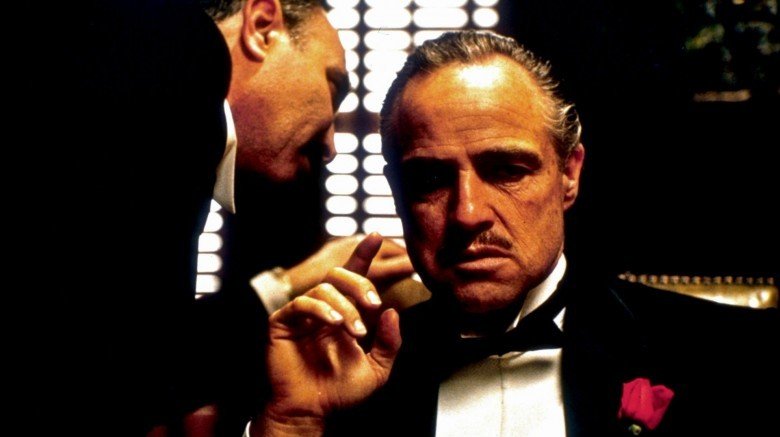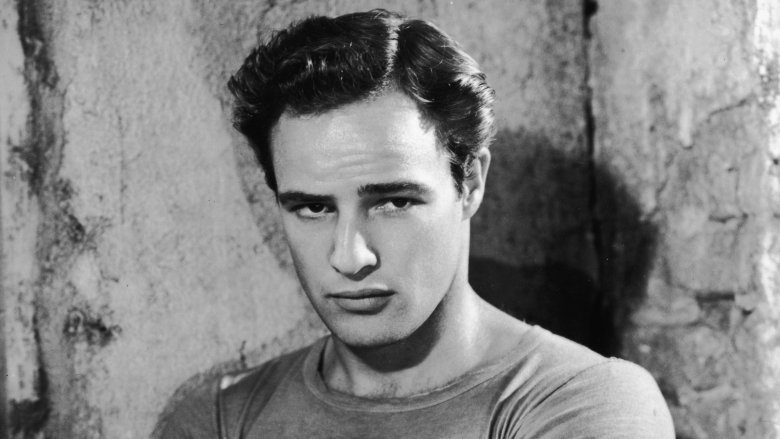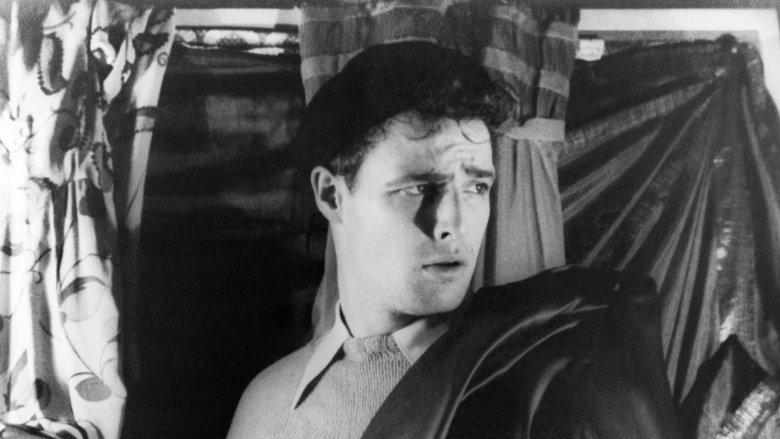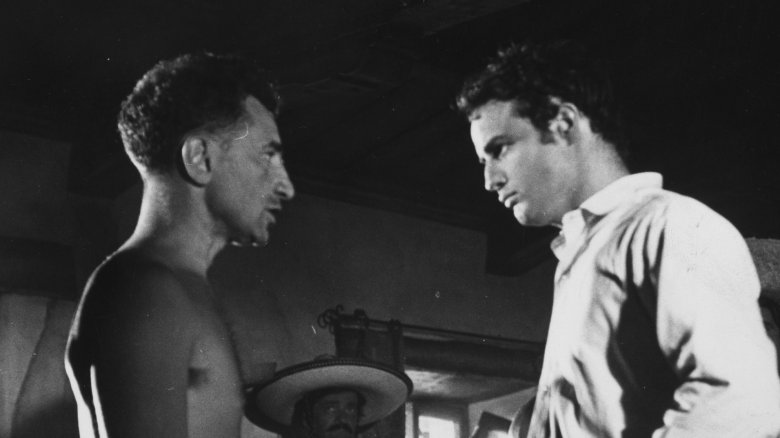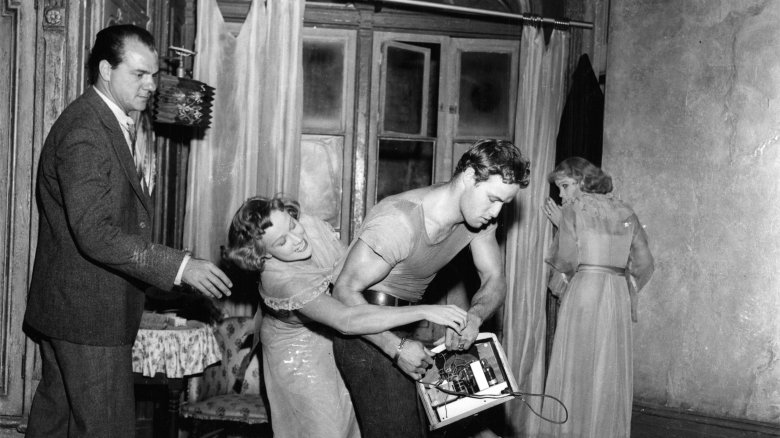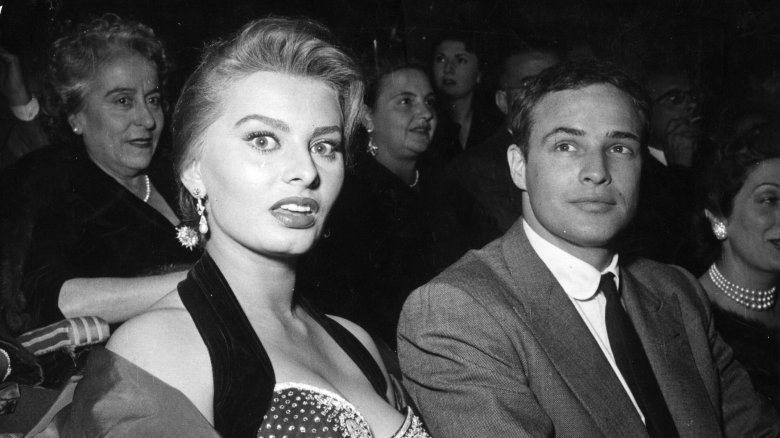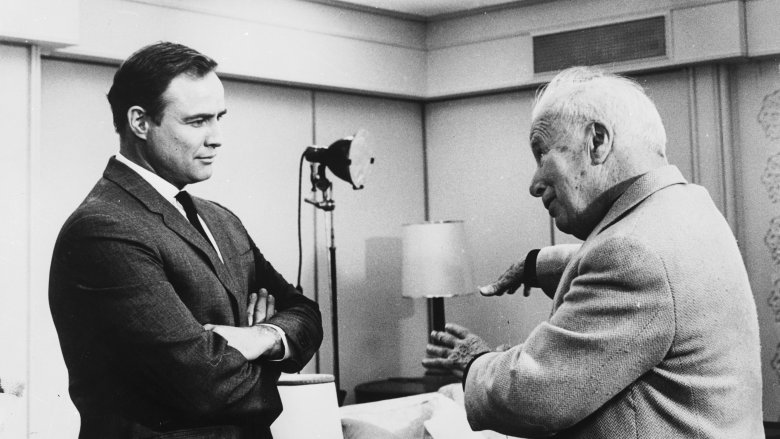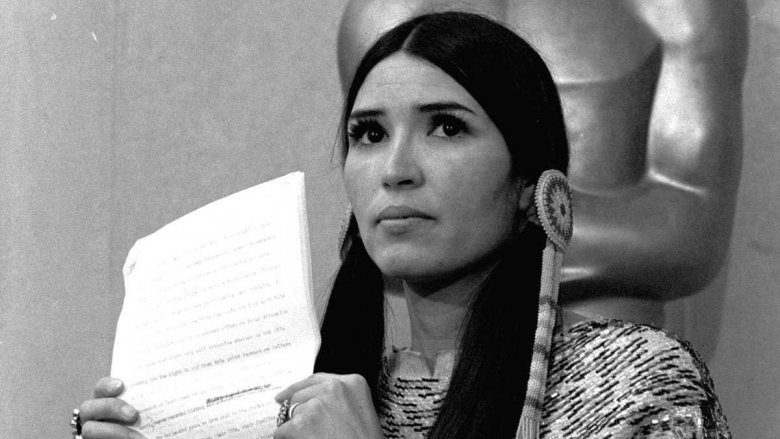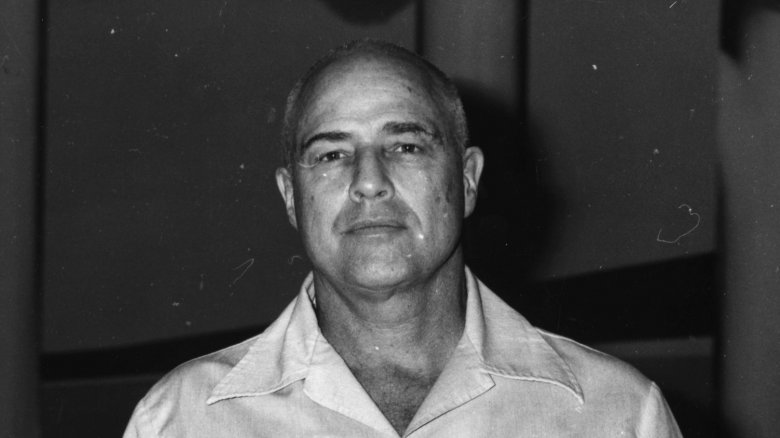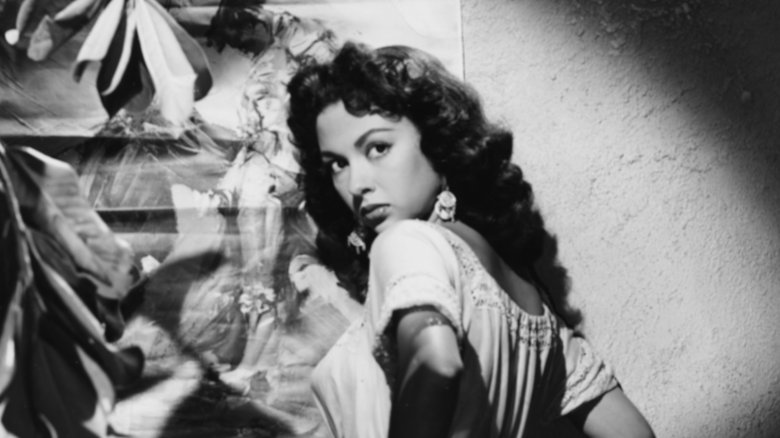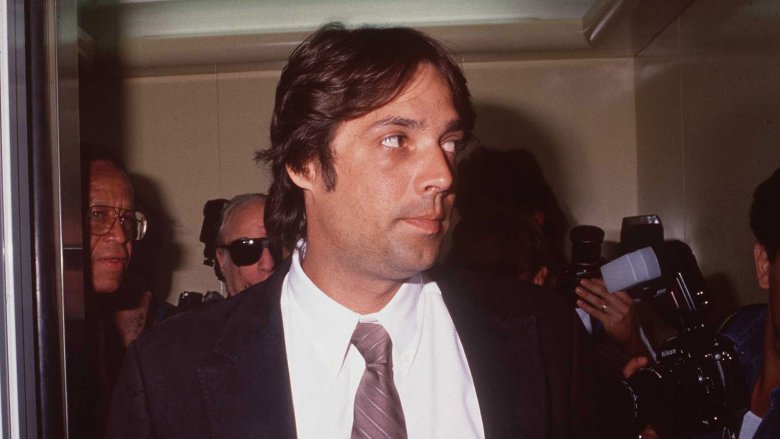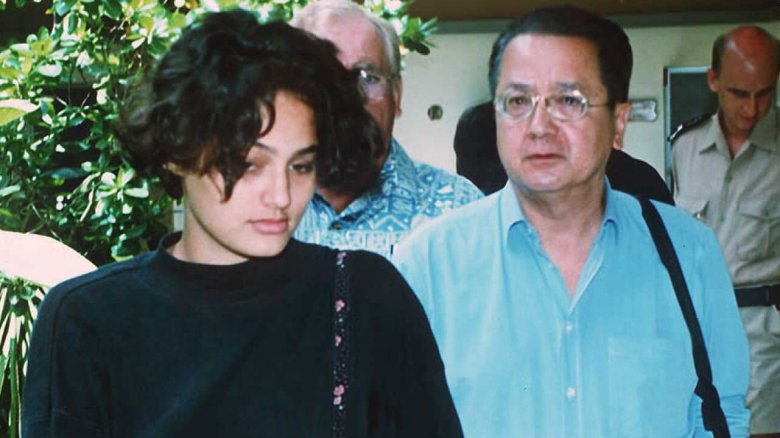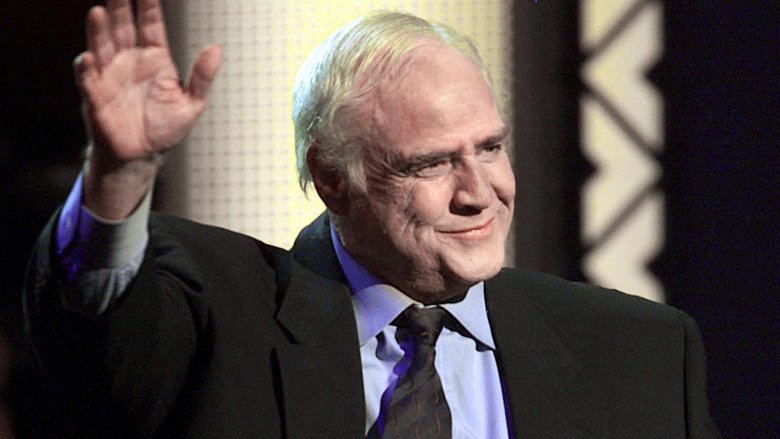Marlon Brando's Tragic Real-Life Story
Marlon Brando was the greatest actor of all time — or one of them, at least. You'd certainly be hard pressed to find anyone who doesn't count him among the pantheon of Hollywood's greats. The foundation of all that intensity and that talent and that masculine bravado, however, was a life marked by misery.
Brando's existence was one of abuse (both given and received), tragedy, and a seemingly perennial decline, almost a paradox for an actor who drowned in adoration and accolades for nearly his entire life. From his troubled childhood to his rise to fame — and subsequent downfall — to the collapse of his family and his eventual, unremarkable end, little about his life inspires jealousy. But somehow, like so many tortured artists before and after him, he managed to find genius in his tragedy. That's why Marlon Brando's name today isn't synonymous with domestic abuse or obesity or murder — it's synonymous with the perfection of the art of acting.
Marlon Brando's parents dealt with demons
Marlon Brando was born in Nebraska in 1924 to Marlon Brando Sr., a chemical manufacturer, and Dorothy Julia. Each of his parents let loose their demons on the young Brando. Both were alcoholics, according to the actor, with his "tyrant father" prone to bouts of violent rage against both Jr. and his mother. Beyond this, Brando Sr. criticized his son relentlessly, imbuing him with a sense of insecurity and inferiority that would stay with him forever. His mother drowned her sorrows with alcohol.
Brando himself claimed the difficulties he had with Hollywood, fame, and authority that plagued him his entire life stemmed from this childhood. His string of girlfriends and romances (which we'll get to in a bit) suffered, too. He had an abandonment complex thanks to his mother, and so he often destroyed his relationships before they ran their course. Brando figured all in all he'd have been better off in an orphanage.
Marlon Brando, the young rebel
Marlon Brando's later childhood — when he was known as "Bud" — was as tumultuous as his early upbringing. At a young age, Bud showed a knack for acting, gaining a reputation for mimicry (most famously of farm animals, as a way to distract his mother from her drinking), but his talent was overshadowed by his troublemaking ways. Brando was better known for his violent tendencies at school and was eventually expelled from Libertyville High School for riding his motorcycle through the halls.
Brando was then sent to Shattuck Military Academy, one of the top boarding schools in the Midwest. There, he gained a reputation for himself as a prankster and a rogue. A teacher at the school, Earle Wagner, was the first to recognize his potential on the stage and took the young Brando under his wing. By 1943, however, Brando had received one demerit too many for Shattuck to accept. Despite a student petition and a threat of resignation from Wagner, the school stuck to its guns and Brando was asked to leave.
Treading the boards
Brando's next step was to attempt to enlist in the U.S. Army, a plan that was scuppered when he failed the first physical exam. With nowhere else to go, he decided to follow the dream first kindled at Shattuck — acting. Brando picked up everything and moved to New York.
In New York, Brando studied acting under the legendary actors Elia Kazan and Stella Adler. Adler taught the Stanislavski method of acting, which directs actors to draw on the character's experience in order to stimulate emotion rather than experiences from the actor's own lives. Essentially, it asks that a performer consider the character rather than themselves. Naturally, it was a method Brando perfected. He made his Broadway debut in 1944 with I Remember Mama. With his performance in Truckline Cafe soon after, critics began to take notice of the young actor. Marlon Brando was becoming a name with value.
Marlon Brando's infallible method
Over the ensuing decades, Marlon Brando would become known as one of history's greatest method actors. According to Tony Curtis, he is "the epitome of actors today, and all actors since the 1950s have been mimicking him." There are dozens of stories floating around Hollywood about how he put his talent into action. In 1954's On the Waterfront, he improvised using a glove to toy with Eva Marie Saint's character after she dropped it during a rehearsal.
In Truckline Cafe, Brando's character was supposed to appear on-stage having emerged from an icy lake. Every night, before that scene, Brando would climb up and down the stairs until he was breathless before having a stage assistant throw a bucket of ice water over his head. While preparing for a role in Fred Zinnemann's The Men, Brando refused to leave his bed or his wheelchair in a veteran's hospital to capture the mindset of a wounded vet. His teacher, Elia Kazan, would say of the young Brando that "it's like he's carrying his own spotlight."
Marlon Brando struggled against fame
Fame soon found Marlon Brando. After a now-legendary stint on Broadway came to a climax with his turn in A Streetcar Named Desire, he made his Hollywood debut with The Men. He went on to appear in Viva Zapata, Julius Caesar, and The Wild One, but it was On the Waterfront that really put him on the map. The only problem was that Brando was much happier off the map. For example, he rudely dismissed the renowned director Roberto Rossellini solely because Rossellini had told him it was an honor to meet him.
According to Ellen Adler, daughter of Stella and a lifelong friend of Brando's, "he loved to study people. And being famous got in the way of that. Because now they were looking at him instead of the way it had been before. Before the fame."
In 1954, Brando won his first Academy Award for his portrayal of Terry Molloy in On the Waterfront.
From the peak into the trough
The 1950s were arguably Marlon Brando's best years. On the Waterfront and A Streetcar Named Desire had garnered him critical acclaim, while subsequent movies like Mutiny on the Bounty turned him into a household name. He had won one Oscar, been nominated for three others, directed his first feature film — One-Eyed Jacks — and had acquired a reputation as one of Hollywood's most bankable leading men.
The 1960s were arguably Brando's worst years. To his fellow actors, he had become known for his erratic behavior and unpredictability, often irritating his co-stars by rewriting lines on the fly and forcing retake after retake to perfect his scenes. More than this, though, he began to fight back against his own fame by referring to acting as an "empty and useless profession," and dismissing Hollywood as nothing more than a way to earn a good paycheck. The films he starred in during the '60s were of a lesser quality than those of the '50s, and, by the time he finally found the role that made him a legend, he was known throughout the film industry as little more than a self-indulgent, greedy has-been.
Marlon Brando declared war on Hollywood
The Godfather was the movie that saved Marlon Brando's career. His portrayal of the ruthless yet deeply protective New York Mafia patriarch Don Corleone is nothing short of iconic. The box office rewarded him: The Godfather went on to gross $135 million in the United States alone, became known as one of cinema's greatest films, and secured him a second Academy Award.
This time, however, he would make a decision that would shock his Hollywood cohorts. Just prior to the 45th Awards ceremony, Brando announced he would be boycotting the ceremony and sending Sacheen Littlefeather, a relatively obscure Native American actress, to pick up the award in his place. Littlefeather passed on Brando's distaste for Hollywood's treatment of Native Americans to boos from some and cheers from others. The appearance was followed by a torrent of criticism leveled against Brando and Littlefeather by the film industry, but brought awareness of a serious issue to over 85 million people. It remains one of the most impactful statements in Oscar history.
Marlon Brando comes to 'Nam
If The Godfather gave Marlon Brando icon status, the Vietnam War epic Apocalypse Now cemented it — with a price. The production for Apocalypse Now was famously one of the most troubled in cinema history. What was supposed to be a challenging, 14-week shoot in the Philippines soon turned into a nightmarish concoction of logistical chaos, weather issues, and bad luck. Martin Sheen, the actor brought in to replace Harvey Keitel after two weeks, was an alcoholic. Francis Ford Coppola was rewriting the movie as he shot it. The crew was riddled with disease, and the helicopters used to shoot combat scenes had to be recalled to fight in the country's actual war.
And then there was Brando. When he arrived on set, supposedly to play the Green Beret legend Colonel Kurtz, he weighed nearly 300 pounds. Brando had failed to prepare at all for the role, with no idea about the character's history and few lines learned. One day, he shaved off all his hair and decided to improvise every one of his scenes. He also demanded that he be blanketed in shadow for most of the movie. And while Apocalypse Now went on to become a true classic, problems with his royalty checks meant that Brando despised Coppola and the movie for the rest of his life.
A long, complicated love life
Marlon Brando's romantic entanglements were, as you'd expect, just as turbulent as the rest of his life. He was married three times: to Anna Kashil, Movita Castaneda, and Tarita Teriipaia, and had children with each. Brando also nurtured a 14-year affair with a maid called Maria Cristina Ruiz. They had three children. Including a few adoptions along the way, Brando's total confirmed number of children is 11, though it could be much higher.
Brando also had more than a few flings, both inside and outside of his marriages. There are rumors of affairs with Jackie Kennedy, Richard Pryor, Jackie Collins, Marilyn Monroe, James Dean, James Baldwin, Shelley Winters, and Heidi Fleiss. Many of these relationships were punctuated by tragedy. Rita Moreno (above), with whom Brando had an affair during his prime, has since revealed that their time together was sullied with cheating, emotional betrayals, physical abuses, an illegal abortion, and a suicide attempt. To the men and women he slept with, Brando's touch often led to disaster.
Christian Brando and the murder of Dag Drollet
Of the many children Marlon Brando adopted or fathered during his life, perhaps the most notorious is his son Christian Brando. A product of his marriage to Anna Kashil, Christian suffered a troublesome childhood of his own, being occasionally picked up by the police for minor infractions and frequently ending up on the receiving end of his father's violent ways.
He dropped out of school in 1976 to live a decadent life in his father's house, and later ended up in his own difficult marriage to Mary McKenna. He was forced into rehab by his father for his drug problems and struggled to succeed working in Hollywood. Cheyenne Brando, Christian's younger sister, was meanwhile engaged in a relationship with Dag Drollet and had become pregnant with his child. Events came to a climax when, in 1990, Christian shot Drollet in the TV room of the elder Brando's Los Angeles home. A highly-publicized court case followed, helmed by Brando, which resulted in Christian pleading guilty to manslaughter and getting five years in prison.
Cheyenne's death
Cheyenne herself had no easy life. She had made a bit of a name for herself as a model and was receiving psychological counseling for herself due to a car accident when Drollet was shot. The trial of Christian Brando took a heavy toll on her mental health, and Cheyenne twice attempted suicide before her brother's conviction. As the trial was going on, Marlon Brando had sent her to Tahiti to give birth and receive psychiatric treatment, which prevented her from testifying in court — despite the prosecution's attempts to convince her to return. Her absence prevented Christian from being tried for murder, and secured him a shorter sentence upon conviction.
In the ensuing years, Cheyenne's depression worsened. She flew to Paris in 1991 to receive treatment for a nervous breakdown but disappeared six months later. Later that year, she was arrested by French police for complicity in her late boyfriend's death before being extradited to Tahiti, where the charges were dismissed. Finally, in 1995, she took her own life.
Marlon Brando's final bow
Marlon Brando's final years were not glorious. He appeared in a handful of movies during the '80s and '90s, including The Formula, Christopher Columbus: The Discovery, and The Island of Dr. Moreau. Most of these were critically panned and none succeeded at the box office, with his failures compounded by the fact that Brando's name often appearing on the list of nominees at the Golden Raspberry Awards.
Media focus was fixed almost entirely on his family, particularly Christian and Cheyenne, and his health began to severely decline, not least because of his obesity. His troublesome on-set antics, too, had far outlasted their charm. Brando's second decline had hit a nadir. In the summer of 2004, Brando died of a pulmonary fibrosis at a hospital in Los Angeles; he was 80 years old. He left behind him a legacy marked as much by violence, death, and disease as it was by his rebelliousness, his charm, and his inimitable talent.
